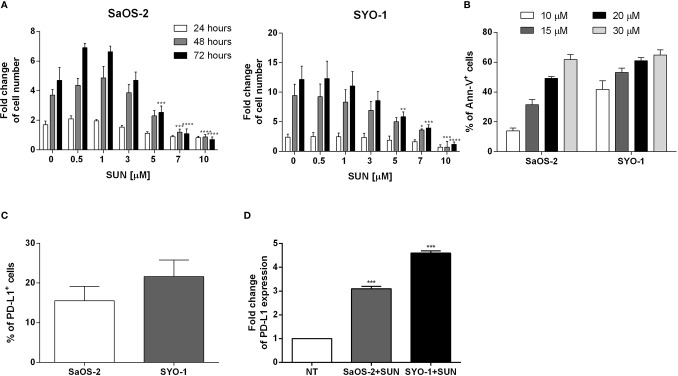Figure 1.
Analysis of sarcoma cell proliferation, apoptosis and PD-L1 expression before and after sunitinib treatment. (A) SaOS-2 and SYO-1 cell lines were treated for 24, 48, or 72 h with sunitinib (SUN) at various concentrations (0, 0.5, 1, 3, 5, 7 and 10 μM). The cell number was determined by colorimetric assay. Untreated cells (DMSO + 0 μM sunitinib) were used as negative control. The values are represented as mean ± SEM of 5 independent experiments. *p < 0.05; **p < 0.01; ***p < 0.001; ****p < 0.0001 compared to untreated cells. (B) SaOS-2 and SYO-1 cell lines were treated for 24 h with sunitinib at various concentrations (10, 15, 20 and 30 μM) and analyzed by flow cytometry. The percentages of apoptotic Ann-V+ cells were calculated as differences between treated and untreated cells + DMSO. The concentrations which made it possible to achieve an apoptosis level of approximately 50% were chosen for the following functional experiments (20 or 15 μM sunitinib for SaOS-2 or SYO-1, respectively). The values are represented as mean ± SEM of 5 independent experiments. (C) Flow cytometry analysis of PD-L1 expression before and (D) after 24 h of sunitinib treatment at concentrations of 20 μM for SaOS-2 and 15 μM for SYO-1 cell lines (SaOS-2+SUN and SYO-1+SUN). The percentage of PD-L1 expression was expressed as fold change. Untreated cells (no treatment; NT) were used as reference and set at 1. The values are represented as mean ± SEM of 5 independent experiments. *p < 0.05; **p < 0.01; ***p < 0.001; ****p < 0.0001 compared to untreated cells.

